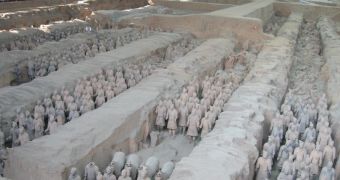Since their discovery in 1974 in Shaanxi province, the ancient Chinese terracotta army posed a puzzle:
Ancient pollen could lead scientists to the kilns where the figures in China's terracotta army were made.
The 2,200-year-old clay army made of 8,099 soldiers, 300 horses and 200 chariots guards the tomb of Qin Shihuang (260-210 BC), the first emperor of the unified China (from Quin dynasty comes the western name of the country, China; Chinese people call themselves Han).
Soils from various regions contain different pollen "signatures", reflecting local vegetation patterns, like a fingerprint that could help understand where the clay figures were made.
A team at the Chinese Academy of Sciences in Beijing led by Hu Ya-Qin analyzed fragments of terracotta from a horse and a soldier and under a microscope they detected 32 types of pollen, but pollen's signature was different in the horse and soldier.
The horse's pollen originated mainly from trees and resembled the pattern found in soil taken from pits in the emperor's mausoleum while the pollen from the terracotta warrior was mainly originating from herbaceous plants.
This could mean the horses were fabricated near the emperor's mausoleum. "The horses were heavier than the soldiers, with more fragile legs. Making them locally would have minimized the effort involved in transporting them and reduced breakages," explained Dr. Hu.
Archaeologists have found ancient kilns in the region, but by now it has not been determined if they were employed for making the terracotta army. The research was "one important step towards solving the mystery of where the clay army came from. But using pollen has its advantages and disadvantages." said Dr Arlene Rosen, from the Institute of Archaeology at University College London, UK.
When the clay comes from an area located close to a running water, alien pollen from various sources can be added by the water. The clay can also contain pollen from an older source, signaling information about previous vegetation, before the time of the terracotta army. "There were more accurate ways to trace the source of clay used in archaeological artefacts. These include analysis of the temper - coarse-grained material added to stop the clay from cracking as it dries - through X-ray diffraction", said Dr. Rosen.

 14 DAY TRIAL //
14 DAY TRIAL //